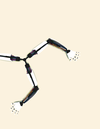Bodhi Linux and the Moksha desktop
|
From the Drive
As with live operation, Bodhi Linux loads the Midori web browser from the hard drive and also a local web page that provides instructions for the installation and use of the system. Because the operating system performs updates automatically, an Internet connection is required.
The Network Connections entry in the Applications | Preferences submenu is used to create access to a WiFi network. In testing, Bodhi Linux displayed deficiencies in recognizing hardware. For example, it did not recognize the WiFi Bluetooth Combo card integrated into a notebook. The connection was generated only after an external WiFi dongle was used.
In the panel, Bodhi Linux indicates how the network access is functioning after a short wait time. The eepDater tool for updating the system is found in the Applications | System Tools menu.
The tool has an intuitive program window, which appears once it is called via a left mouse click. A list containing every package for which an update is available will appear once a request is made to the update server (Figure 2). In the first column – named Upgrade – you should select each package that you would like to upgrade by setting a check mark. Then, with a click on Apply at the upper right of the window, eepDater installs the latest updates for the selected package.
The Desktop
After the migration from Enlightenment E18 to E19 for the Bodhi Linux 3.0.0 desktop, the developers did a turnabout with the introduction of the Moksha work interface for the new version 3.1.0. According to Jeff Hoogland, who is the thought leader behind Bodhi Linux, the Enlightenment E19 desktop proved to be quite plodding and resource hungry, especially for older computers.
Moreover, the development philosophy of the E19 project began to clash with the philosophy of the distribution. The Bodhi developers wanted to give the users freedom for configuration.
The Enlightenment project curtailed such freedom in favor of what they thought was more ease of use. Additionally, cooperation between the operating system developers and the desktop programmers grew ever more difficult. Delays occurred in fixing bugs in the E19 desktop because the Enlightenment team had devoted all of its energies to the successor version E20.
These unfortunate difficulties quickly led to the forking of the Moksha project from Enlightenment [3]. The underlying Enlightenment E17 work interface for the Moksha desktop is extremely stable and also almost entirely bug free due to years of maintenance.
« Previous 1 2 3 4 Next »
Buy this article as PDF
Pages: 4
(incl. VAT)







